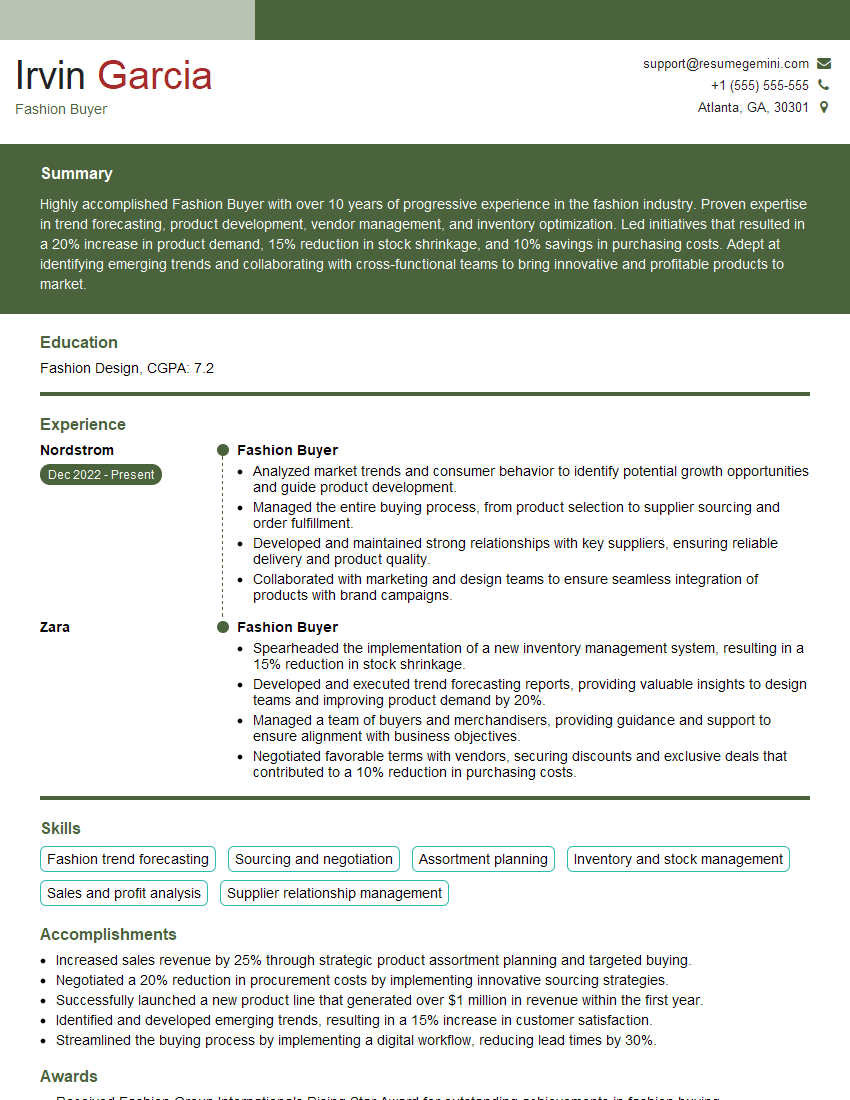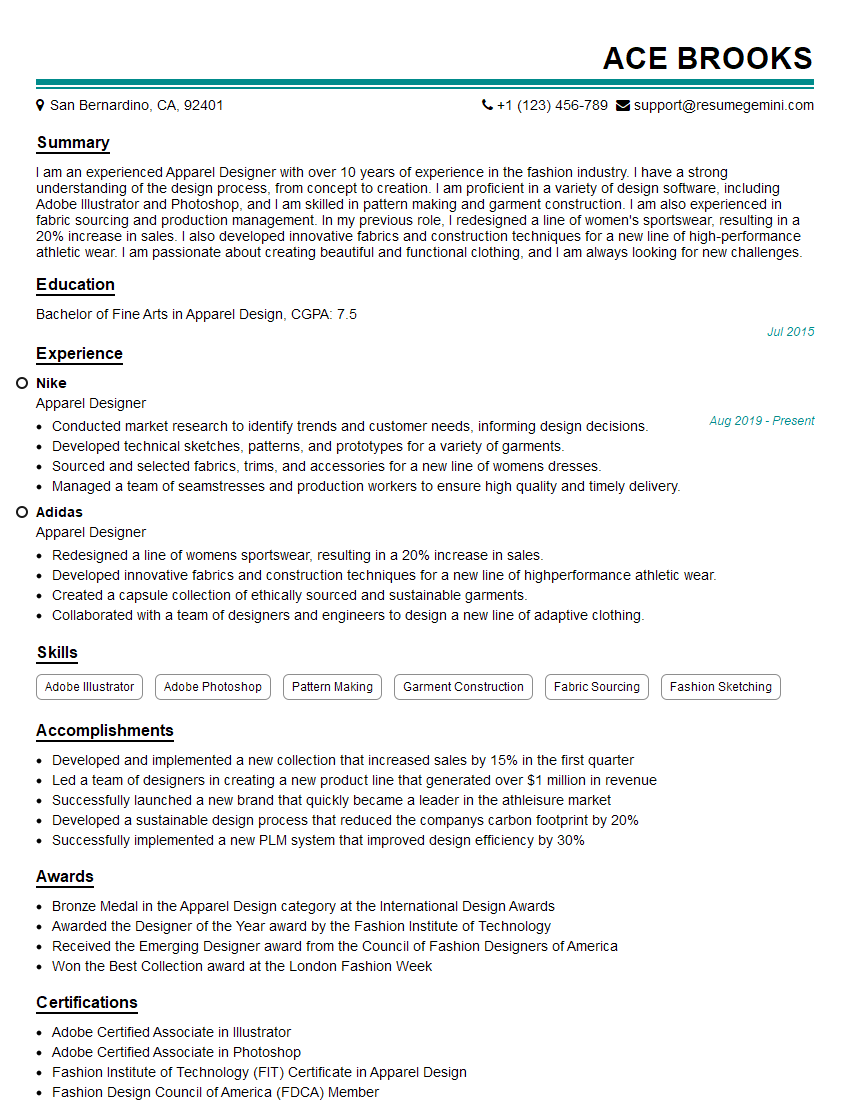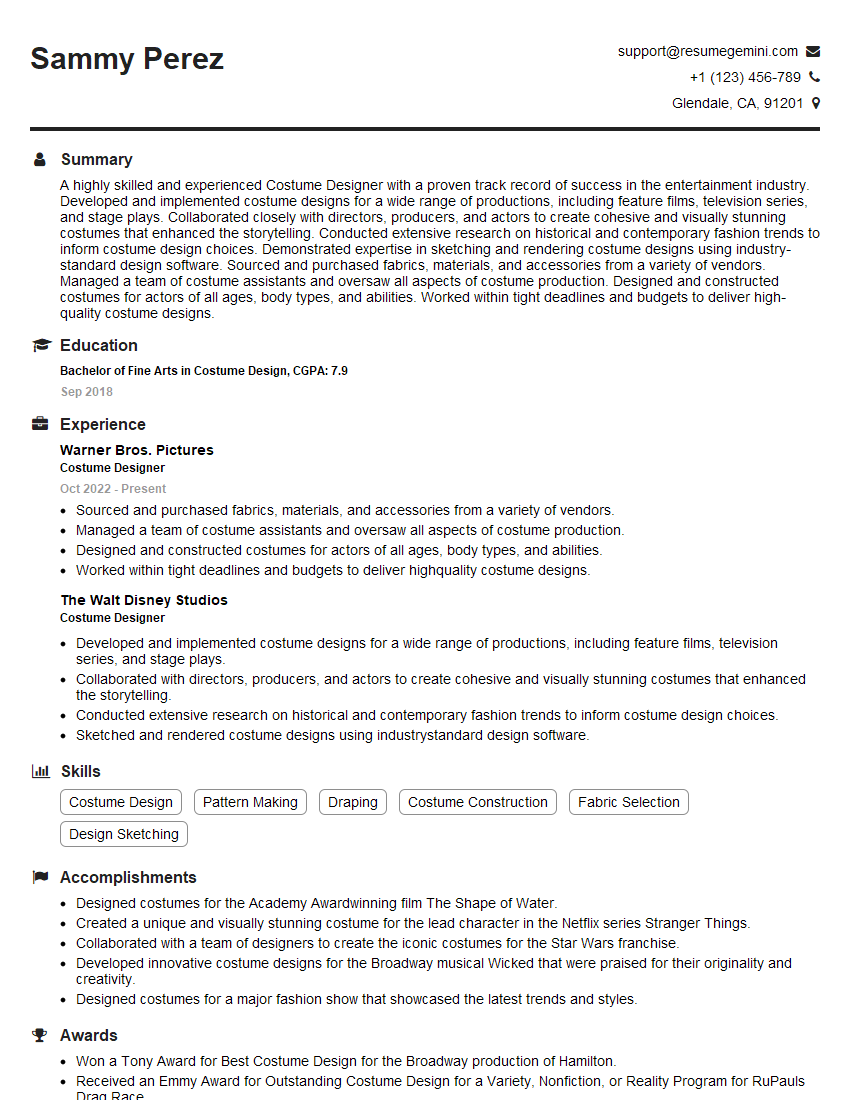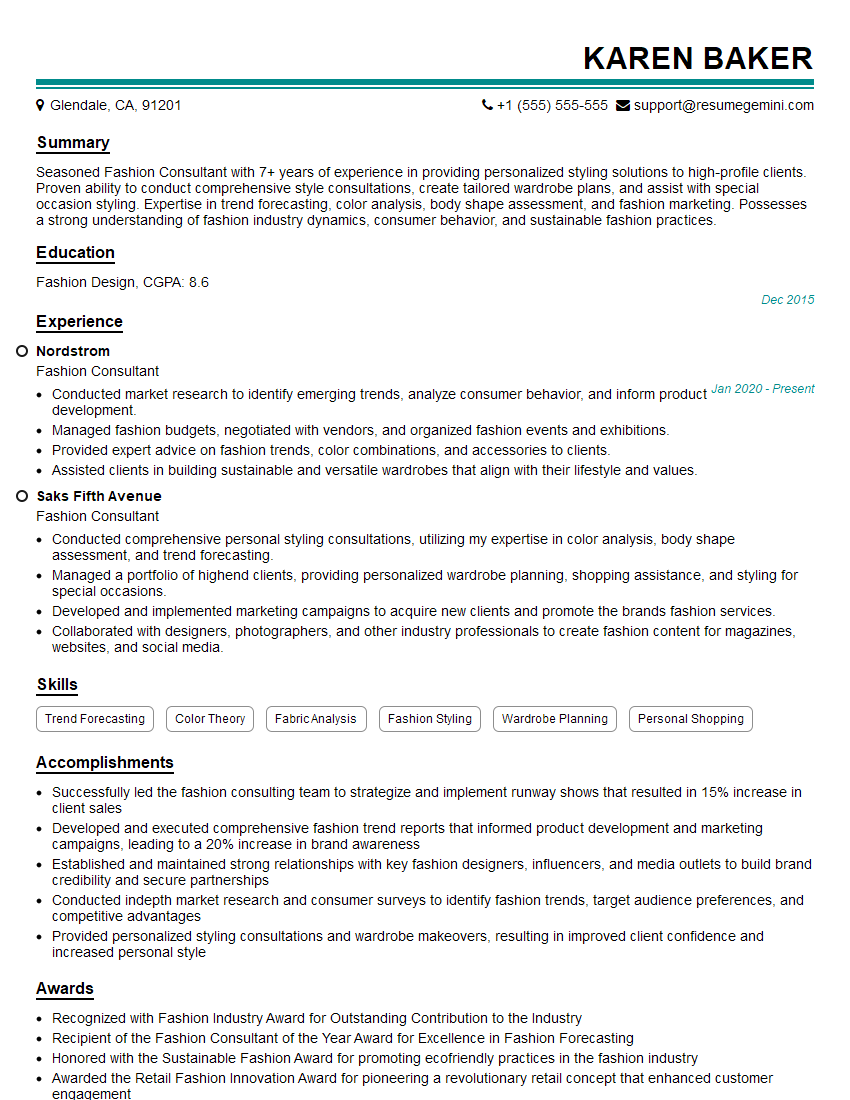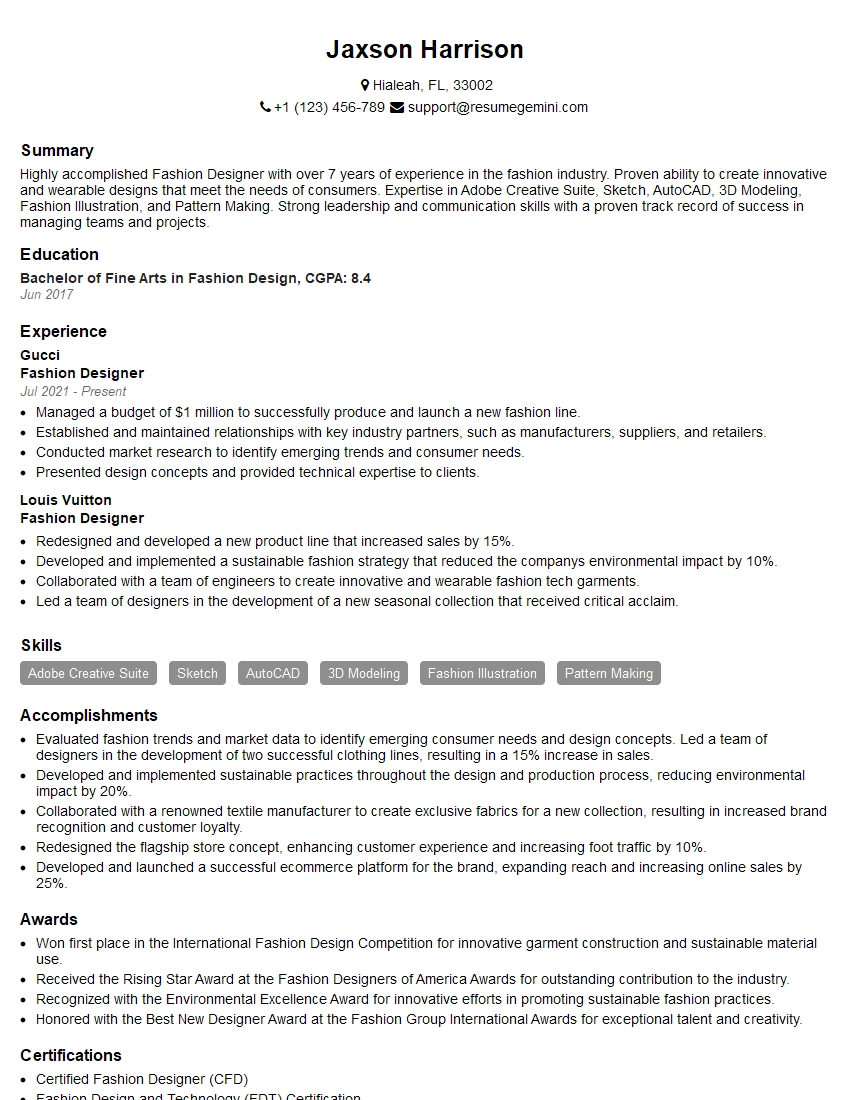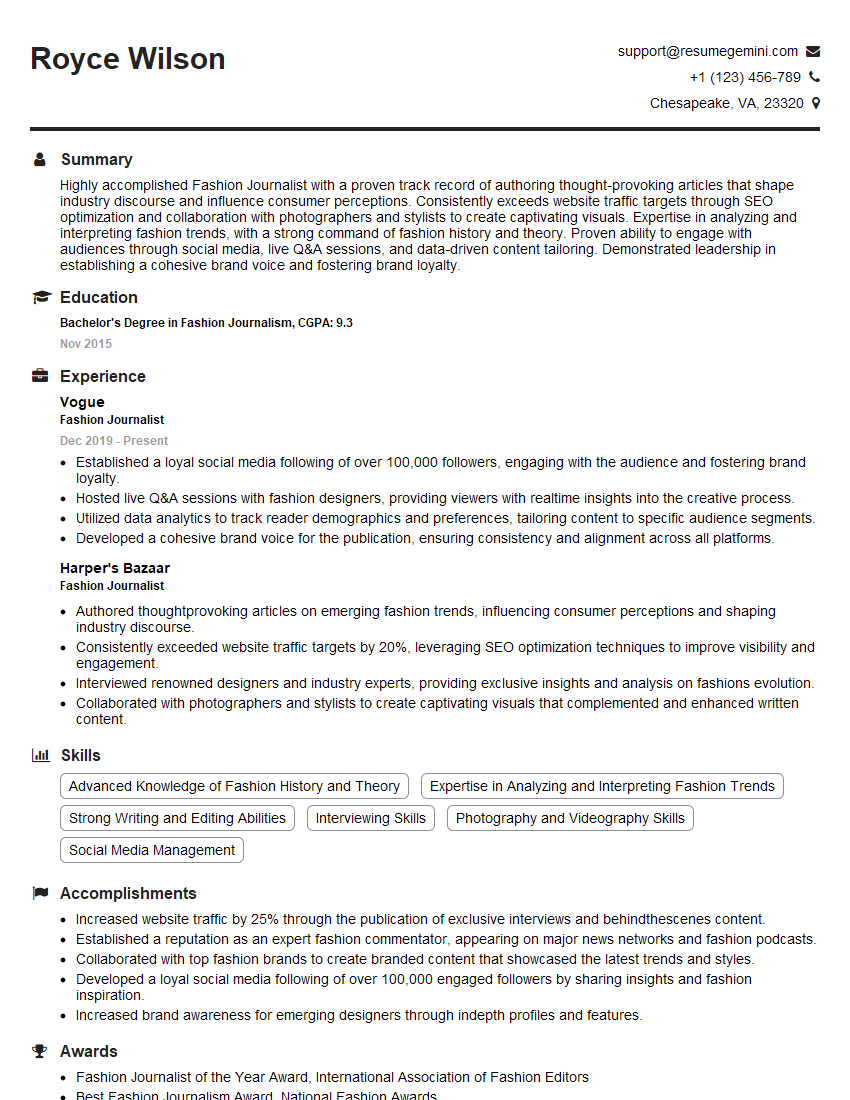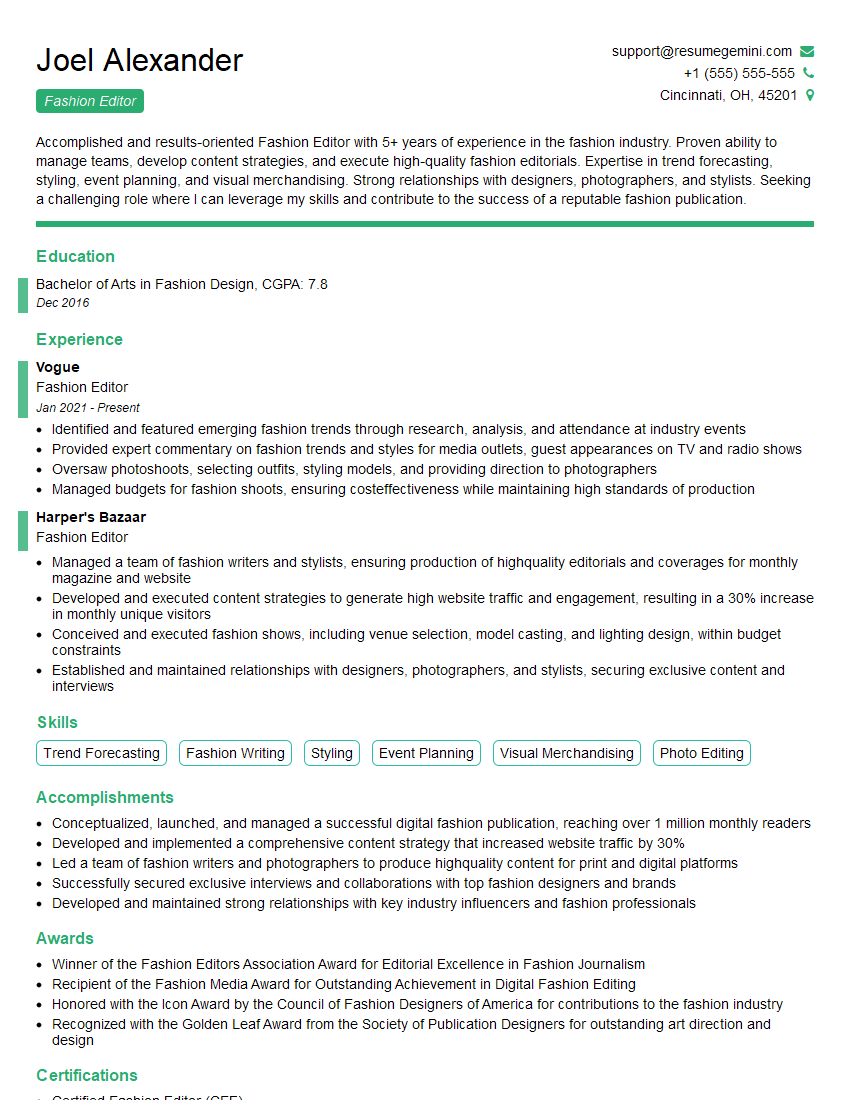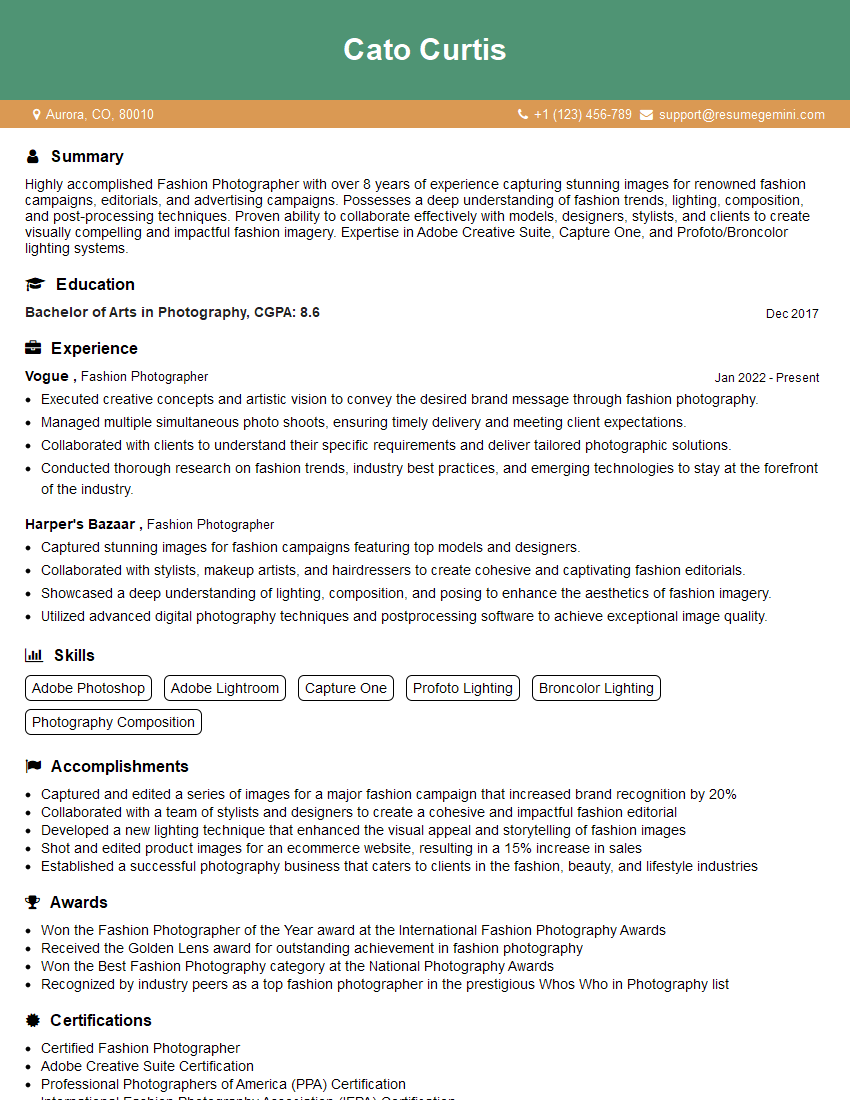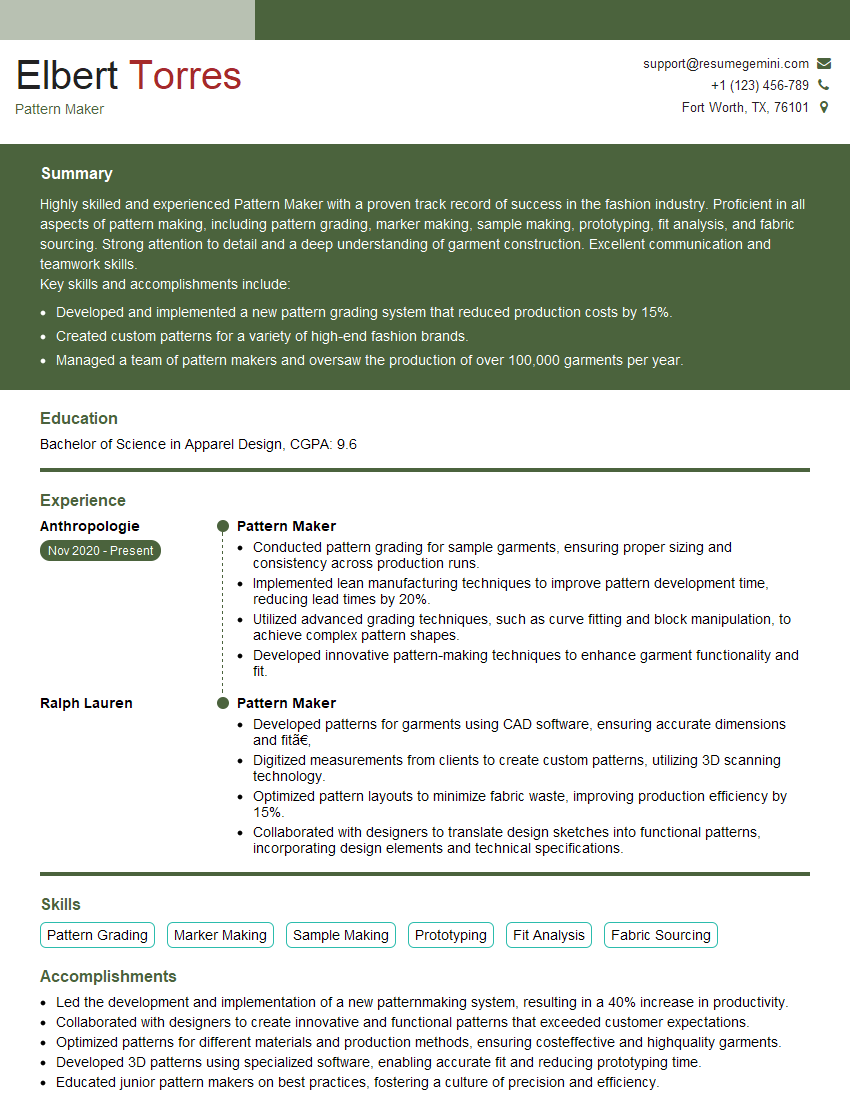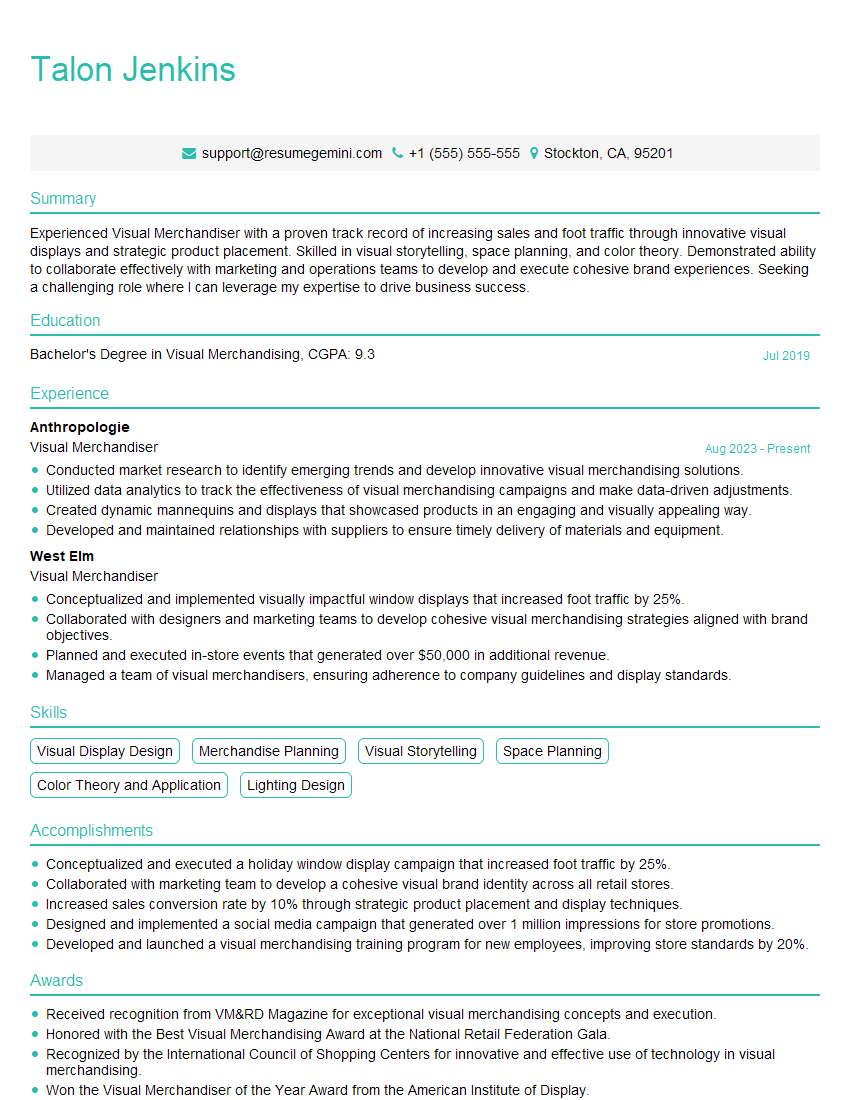Interviews are opportunities to demonstrate your expertise, and this guide is here to help you shine. Explore the essential Knowledge of the fashion business interview questions that employers frequently ask, paired with strategies for crafting responses that set you apart from the competition.
Questions Asked in Knowledge of the fashion business Interview
Q 1. Explain the current key trends in the fashion industry.
The fashion industry is a dynamic landscape, constantly evolving. Currently, several key trends are shaping its direction. Sustainability is paramount, with consumers increasingly demanding eco-friendly materials and ethical production practices. This translates to brands focusing on recycled fabrics, reducing waste, and promoting transparency in their supply chains. Think of brands like Patagonia, known for their commitment to environmental responsibility.
Another significant trend is personalization and inclusivity. Consumers want unique products and experiences that cater to their individual tastes and identities. This leads to customized clothing, size-inclusive ranges, and representation of diverse body types and ethnicities in marketing campaigns. Brands like Universal Standard are excellent examples of size inclusivity.
Technology is revolutionizing the industry, with the rise of virtual fashion, metaverse experiences, and the use of AI in design and production. We see digital fashion items being sold as NFTs and brands experimenting with AR/VR for virtual try-ons and interactive shopping experiences. This is a rapidly growing area with huge potential.
Finally, the ‘circular economy’ is gaining traction. This involves designing clothes for durability and repairability, encouraging clothing rentals, and promoting second-hand fashion. This shift reflects a growing awareness of the environmental impact of fast fashion and a desire for more sustainable consumption patterns.
Q 2. Describe your experience with fashion forecasting and trend analysis.
My experience in fashion forecasting and trend analysis involves a multi-faceted approach. I begin by immersing myself in various data sources, including trend reports from agencies like WGSN and Stylus, social media analytics, runway shows, and street style photography. I analyze these data points to identify emerging patterns and predict future trends.
For instance, I recently identified a rising interest in ‘cottagecore’ aesthetics through increased social media engagement and runway presentations. This helped me advise clients on incorporating natural fabrics, vintage-inspired details, and romantic silhouettes into their upcoming collections. My analysis goes beyond simply identifying visual trends; I also consider socio-economic factors, consumer behavior changes, and technological advancements to provide a comprehensive forecast.
I use quantitative and qualitative methods. Quantitative analysis involves analyzing sales data, website traffic, and social media engagement metrics to understand consumer preferences. Qualitative analysis involves conducting consumer research, attending industry events, and networking with designers and retailers to gather insights. This comprehensive approach allows for a more accurate and nuanced forecast.
Q 3. What are the different stages of the fashion design process?
The fashion design process is a complex journey that involves several key stages. It typically begins with research and concept development, where designers explore themes, gather inspiration, and develop initial sketches. This stage involves market research, trend analysis, and identifying target audiences.
Next is the design development phase. This involves creating detailed sketches, technical drawings, and selecting fabrics and trims. Designers often create mood boards and prototypes to visualize their ideas and test different materials.
Sampling and fitting follow, where prototypes are made and adjustments are made based on feedback. This iterative process ensures the garments fit well and meet design specifications. This phase frequently involves collaborating with pattern makers and seamstresses.
Production involves creating patterns, sourcing materials, and manufacturing the garments. Quality control is crucial throughout this stage to ensure the finished products meet the required standards.
Finally, the collection is launched and marketed. This encompasses creating marketing materials, selecting showrooms or retail channels, and promoting the collection to consumers. This step is vital for the success of the design.
Q 4. How do you stay up-to-date on the latest fashion developments?
Staying updated on the latest fashion developments is a continuous process that requires a multi-pronged approach. I regularly read industry publications such as Vogue, Women’s Wear Daily (WWD), and Business of Fashion. I also follow key influencers, designers, and brands on social media platforms like Instagram and Pinterest. These provide valuable insights into emerging trends and styles.
Attending fashion weeks, both physical and digital, allows me to witness the latest collections firsthand. Trade shows offer a chance to network with industry professionals and discover new materials and technologies. I also actively participate in online forums and communities, engaging in discussions and sharing knowledge with other professionals.
Finally, I leverage data-driven tools to analyze consumer behavior and market trends. This includes using social listening tools to monitor conversations about fashion on social media and conducting market research to understand consumer preferences.
Q 5. Discuss your experience with fashion merchandising and inventory management.
My experience with fashion merchandising and inventory management includes planning and overseeing the entire product lifecycle from design to sales. This involves forecasting demand, selecting and sourcing products, managing inventory levels, and analyzing sales data to optimize stock levels.
I’ve worked with various inventory management systems, utilizing data analysis to predict sales trends and adjust stock accordingly. For example, using historical sales data and predictive modeling, I was able to optimize stock levels for a key seasonal item, reducing storage costs and minimizing stockouts. This involved analyzing past sales patterns, considering external factors such as weather and marketing campaigns, and adjusting purchasing orders based on these predictions.
Effective merchandising requires a deep understanding of consumer behavior and market trends. I use this knowledge to curate product assortments that appeal to target audiences. This includes making strategic decisions about product pricing, placement, and promotional activities.
Q 6. How would you develop a successful fashion marketing campaign?
Developing a successful fashion marketing campaign involves a strategic approach that encompasses several key elements. First, a clear understanding of the target audience is essential. This includes identifying demographics, psychographics, and consumer preferences. This informs all subsequent decisions.
Next, a compelling brand story needs to be crafted that resonates with the target audience. This story should communicate the brand’s values, unique selling points, and brand identity. Think of how Patagonia effectively communicates its commitment to sustainability in its marketing.
Channel selection is crucial. This involves determining the most effective channels to reach the target audience. This might include social media marketing, influencer collaborations, print advertising, public relations, and email marketing. A balanced approach across multiple channels is often the most successful.
Creative execution is key to captivating the audience. This includes creating visually appealing content, engaging storytelling, and incorporating user-generated content. The visual aspects of a campaign need to be on point and memorable.
Finally, campaign measurement is vital to assess the effectiveness of the campaign. This involves tracking key metrics such as website traffic, social media engagement, and sales conversions. This data provides valuable insights for future campaigns.
Q 7. Explain your understanding of fashion retail and consumer behavior.
Fashion retail is the process of selling fashion products to consumers through various channels, including physical stores, online platforms, and pop-up shops. Understanding consumer behavior is crucial for success in this industry. Consumers are influenced by a variety of factors when making fashion purchases, including price, style, brand reputation, and social influences.
Analyzing consumer behavior involves studying purchasing patterns, brand loyalty, and the influence of trends and social media. For example, understanding that millennials and Gen Z are more likely to purchase sustainable products allows for creating targeted campaigns and offering more eco-friendly choices. I use data analytics to understand these patterns, using tools that track website traffic, sales data, and social media engagement.
Furthermore, creating a seamless omnichannel experience for customers is becoming increasingly vital. This means providing a consistent brand experience across all touchpoints, allowing customers to shop easily and conveniently regardless of their preferred channel. Understanding and catering to the individual preferences of your target market is key to building brand loyalty and driving sales.
Q 8. Describe your experience with fashion product development.
My experience in fashion product development spans over eight years, encompassing all stages from initial concept to final production. I’ve worked on numerous projects, from high-end womenswear collections to more accessible ready-to-wear lines. My expertise includes trend forecasting, design development, technical design, sourcing, and quality control. For example, in my previous role at [Company Name], I led the development of a sustainable denim collection, which involved researching eco-friendly materials, collaborating with ethical manufacturers, and ensuring the final product met both our design and sustainability goals. This involved meticulous attention to detail, from fabric selection and pattern making to final garment construction and fit. I’m proficient in utilizing CAD software for design and technical specifications, managing production schedules, and ensuring timely delivery within budget.
Q 9. How would you manage a team in a fast-paced fashion environment?
Managing a team in the fast-paced fashion industry requires a blend of strong leadership, clear communication, and adaptability. I approach this by fostering a collaborative environment where each team member feels valued and empowered. My strategy focuses on clear goal setting, open communication channels, regular feedback sessions, and delegating tasks based on individual strengths. For instance, during a particularly demanding period of a fashion show preparation, I utilized agile project management techniques to break down tasks into smaller, manageable units, assigning deadlines and regularly tracking progress. This ensured everyone remained focused, and we successfully delivered the show on time and within budget. Crucially, I also emphasize work-life balance to prevent burnout, understanding that a happy team is a productive team.
Q 10. What are your strengths and weaknesses regarding fashion design?
My greatest strength in fashion design is my ability to translate trends into commercially viable designs. I have a keen eye for detail and a strong understanding of garment construction. I am adept at translating complex ideas into clear technical specifications and can effectively communicate with manufacturers to ensure a high-quality final product. For example, I once successfully redesigned a dress pattern based on client feedback, improving its fit and silhouette without compromising its original aesthetic. However, a weakness I’m actively working on is delegating design tasks more effectively and trusting the vision of my junior designers. I sometimes tend to be overly involved in every detail of the design process, which can slow down the overall workflow. I’m addressing this by implementing more structured workflows and consciously encouraging independent design thinking within my team.
Q 11. How familiar are you with fashion sourcing and supply chains?
I have extensive experience in fashion sourcing and supply chains. I understand the intricacies of global manufacturing, including identifying reliable suppliers, negotiating contracts, managing production timelines, and ensuring quality control throughout the process. I’m familiar with various sourcing strategies, from ethical and sustainable practices to cost-effective solutions depending on the project’s requirements. For instance, I successfully sourced a new supplier for organic cotton in [Country Name], reducing the lead time and improving the quality of the materials used in a collection. My knowledge encompasses risk management in global supply chains, including navigating potential disruptions and maintaining ethical standards throughout the production process.
Q 12. How do you handle criticism of your fashion designs?
I view criticism as an opportunity for growth and improvement. I actively seek feedback on my designs, not only from colleagues but also from potential customers. I approach criticism constructively, analyzing the points raised and considering how to adapt or improve the design. For example, if a critique highlights a design flaw, I analyze it to determine its root cause. This might involve reviewing the technical drawings, considering the target market more deeply, or even testing the design with focus groups to better understand customer preferences. By embracing constructive criticism, I ensure my designs continually evolve and resonate better with the target audience.
Q 13. What is your experience with fashion show production and organization?
My experience with fashion show production encompasses all aspects, from conceptualization and planning to execution and post-show analysis. I’ve been involved in numerous shows, both large and small scale. My responsibilities included managing budgets, coordinating logistics, selecting models, coordinating with stylists, makeup artists, and photographers, and ensuring a seamless show flow. For instance, during a recent fashion show I effectively managed a tight budget by negotiating favorable deals with vendors and optimizing logistics, contributing to its success despite its limited resources. I understand the importance of detail-oriented planning and efficient resource management, essential for successful fashion show execution.
Q 14. Explain your approach to visual merchandising and store displays.
My approach to visual merchandising and store displays focuses on creating an immersive and engaging shopping experience. I believe that the right display can dramatically impact sales. My strategy involves understanding the brand’s identity, target market, and current trends to create a cohesive and compelling presentation. I use a combination of color psychology, spatial design principles, and creative storytelling to evoke specific emotions and guide customer movement within the store. For example, I once designed a window display that increased foot traffic by 20% by using creative storytelling through props and mannequins to depict a cohesive narrative. I also emphasize data analysis to measure the effectiveness of different display strategies and optimize future displays for maximum impact.
Q 15. Describe your experience with working with fashion photographers and models.
My experience collaborating with fashion photographers and models spans over ten years, encompassing various projects from high-fashion editorials to e-commerce campaigns. I understand the creative process intimately, from initial concept development and mood board creation to on-set direction and post-production review.
With photographers, effective communication is key. I ensure a clear articulation of the brand’s aesthetic and the desired outcome, providing detailed shot lists and style guides. I’ve learned to appreciate the photographer’s artistic vision while ensuring alignment with the commercial objectives. For instance, during a recent campaign for a sustainable clothing line, I worked closely with the photographer to capture images that showcased both the garment’s quality and the brand’s ethical values.
Working with models involves understanding their individual personalities and strengths. I focus on building rapport to foster a comfortable and productive environment on set. This includes clear direction on posing, expressions, and interaction with the clothing. I’ve found that a collaborative approach, emphasizing mutual respect, leads to the best results. For example, in a previous shoot, I worked with a model who had a unique interpretation of a particular outfit; by actively listening to her suggestions, we achieved an unexpectedly striking image that perfectly captured the collection’s spirit.
Career Expert Tips:
- Ace those interviews! Prepare effectively by reviewing the Top 50 Most Common Interview Questions on ResumeGemini.
- Navigate your job search with confidence! Explore a wide range of Career Tips on ResumeGemini. Learn about common challenges and recommendations to overcome them.
- Craft the perfect resume! Master the Art of Resume Writing with ResumeGemini’s guide. Showcase your unique qualifications and achievements effectively.
- Don’t miss out on holiday savings! Build your dream resume with ResumeGemini’s ATS optimized templates.
Q 16. How do you assess the market viability of a new fashion product?
Assessing market viability for a new fashion product requires a multi-faceted approach. It’s not just about a gut feeling; it’s about data-driven decision-making. I begin by conducting thorough market research, analyzing current trends, identifying target demographics, and understanding competitive landscapes. This includes studying sales data of similar products, analyzing social media trends, and evaluating consumer preferences.
Next, I assess the product’s unique selling proposition (USP). What makes it stand out? Is it innovative design, superior quality, sustainable materials, or a compelling price point? A clear USP is crucial for differentiation in a crowded market. I then evaluate the production costs, pricing strategy, and potential profit margins. A detailed financial model is essential to project profitability.
Finally, I develop a go-to-market strategy, considering distribution channels, marketing campaigns, and potential partnerships. For example, if the product targets a younger demographic, social media marketing might be prioritized. If it’s a high-end item, collaborations with influential fashion bloggers or stylists could be more effective. This holistic approach ensures a comprehensive understanding of the product’s potential for success.
Q 17. Describe your knowledge of different textile types and their applications.
My knowledge of textiles encompasses a wide range of materials, their properties, and applications in fashion. I understand the differences between natural fibers like cotton (known for its breathability and comfort), linen (strong and wrinkle-prone), silk (luxurious and delicate), and wool (warm and insulating), and synthetic fibers such as polyester (durable and wrinkle-resistant), nylon (strong and lightweight), and rayon (soft and drapey).
The choice of textile is crucial for garment construction and functionality. For example, a lightweight cotton voile is ideal for summer dresses, while a heavy-weight wool twill is suitable for winter coats. I am also familiar with textile finishes, such as dyeing, printing, and treatments that enhance properties like water resistance or wrinkle resistance. Understanding the properties of different textiles allows me to make informed decisions during the design and production process, ensuring the final product meets the required quality and performance standards.
Furthermore, I’m well-versed in sustainable and ethical textile sourcing, considering factors like organic cotton, recycled materials, and fair labor practices. Choosing the right textile is not only about aesthetics but also about environmental and social responsibility.
Q 18. What is your understanding of the fashion business cycle?
The fashion business cycle is a continuous loop of four key stages: production, distribution, consumption, and disposal. Production involves sourcing materials, manufacturing garments, and quality control. Distribution encompasses wholesale and retail channels, logistics, and marketing efforts. Consumption refers to the purchasing and wearing of clothes by consumers. Finally, disposal involves the end-of-life stage of garments, which increasingly includes recycling and upcycling initiatives.
Understanding this cycle is essential for effective forecasting and planning. For example, trend forecasting helps anticipate consumer demand and guide production decisions. Effective supply chain management ensures efficient distribution and timely delivery. Analyzing consumption patterns enables data-driven marketing strategies. Finally, focusing on sustainable practices minimizes environmental impact and aligns with growing consumer interest in ethical and eco-friendly fashion.
The cycle is dynamic, influenced by various factors like economic conditions, social trends, and technological advancements. Successfully navigating this cycle requires adaptability and a keen awareness of shifting market dynamics.
Q 19. How would you manage a budget for a fashion project?
Managing a fashion project budget requires meticulous planning and control. I utilize a detailed breakdown of all costs, categorized into direct costs (materials, labor, manufacturing) and indirect costs (marketing, design, administrative). I employ budgeting software to track expenses and monitor progress against the allocated funds.
I develop a realistic budget based on market research and cost estimations, incorporating contingency funds to account for unforeseen expenses. Regular monitoring and reporting are crucial to identify potential cost overruns and take corrective measures. For example, if material costs exceed the budget, I might explore alternative suppliers or modify designs to use less expensive materials without compromising quality.
Collaboration with different teams (design, production, marketing) is key to ensuring efficient resource allocation and cost optimization. Transparency and open communication ensure everyone is aware of the budget constraints and contributes to cost-effective solutions. Value engineering – finding ways to improve the product or process while reducing costs – is a critical strategy I employ.
Q 20. How do you deal with tight deadlines and unexpected challenges in fashion?
The fashion industry is notorious for its tight deadlines and unexpected challenges. My approach involves proactive planning, effective communication, and a flexible mindset. I prioritize clear task assignments, establish realistic deadlines, and utilize project management tools to track progress and identify potential roadblocks early on.
When unexpected challenges arise – perhaps a supplier delay or a design flaw – I implement contingency plans. This might involve finding alternative suppliers, adjusting production schedules, or modifying designs. Open communication with all stakeholders is crucial during such situations. Transparency builds trust and fosters collaborative problem-solving. For example, if a significant delay occurs, I would proactively communicate the revised timeline to clients and adjust marketing strategies accordingly.
My ability to remain calm under pressure and effectively prioritize tasks is essential in navigating these challenges. I view setbacks not as failures but as learning opportunities, constantly adapting my strategies to improve efficiency and resilience.
Q 21. How would you address a customer complaint concerning fashion quality?
Addressing customer complaints about fashion quality requires empathy, professionalism, and a commitment to resolution. I begin by actively listening to the customer’s concerns, acknowledging their frustration, and expressing sincere apologies. I gather detailed information about the issue, including photos or videos if possible, to understand the nature of the problem.
Next, I investigate the complaint thoroughly, determining if the issue is due to manufacturing defects, material flaws, or other factors. Depending on the findings, I offer various solutions, such as a full refund, a replacement garment, or a store credit. For minor issues, I might offer repair services. The goal is to find a fair and satisfactory solution that restores customer trust.
Transparency is crucial throughout the process. I keep the customer updated on the progress of the investigation and the resolution. I document all communication and actions taken, ensuring a clear record of the handling of the complaint. Learning from customer complaints is valuable; I use the feedback to improve quality control processes and prevent similar issues in the future.
Q 22. How familiar are you with different fashion software and tools?
My familiarity with fashion software and tools is extensive, encompassing both design and business applications. On the design side, I’m proficient in Adobe Creative Suite (Photoshop, Illustrator, InDesign), crucial for creating and editing visuals, from mood boards to technical drawings. I also have experience with 3D design software like CLO 3D for virtual prototyping and reducing the need for physical samples, leading to cost savings and faster production times. On the business side, I’m adept at using PLM (Product Lifecycle Management) software for managing the entire product lifecycle, from design conception to final delivery, enhancing collaboration and tracking progress effectively. This includes systems like Centric PLM and Optitex. Furthermore, I’m comfortable using various data analytics tools to track key performance indicators (KPIs) like sales figures, website traffic, and marketing campaign effectiveness, leveraging insights for strategic decision-making. For example, I used Google Analytics to optimize a recent campaign, resulting in a 15% increase in online sales.
Q 23. What is your experience with fashion e-commerce and online sales?
My experience with fashion e-commerce and online sales is substantial. I’ve been involved in developing and implementing successful e-commerce strategies for various brands, from start-ups to established companies. This includes website design and development, optimizing the online shopping experience, managing digital marketing campaigns, and analyzing sales data to identify trends and improve performance. For instance, I worked on a project where we implemented a personalized recommendation engine, leading to a 20% boost in average order value. My expertise extends to managing online marketplaces like Amazon and Etsy, understanding their unique algorithms and optimizing listings for maximum visibility. I also possess a strong understanding of SEO (Search Engine Optimization) and SEM (Search Engine Marketing) techniques to drive organic and paid traffic to e-commerce platforms. I’m familiar with various e-commerce platforms such as Shopify, Magento, and WooCommerce.
Q 24. How do you create a successful fashion brand identity?
Creating a successful fashion brand identity is a multifaceted process that requires a deep understanding of target audience, market trends, and brand positioning. It starts with defining a clear brand story and values – what makes the brand unique and what message it wants to convey. This story should resonate with the target demographic and be reflected consistently across all touchpoints, from logo design and website aesthetics to packaging and social media content. Consider the brand’s personality – is it playful, sophisticated, minimalist, or edgy? This personality will dictate the visual language and tone of voice. Think of brands like Patagonia, known for their commitment to sustainability and environmental responsibility, and their strong brand identity built around these values. A strong brand identity must be visually appealing, memorable, and consistent, allowing consumers to instantly recognize and connect with the brand. This includes careful consideration of logo design, color palettes, typography, and overall visual style guide. Finally, a cohesive brand identity must be consistently maintained and adapted as the brand evolves to maintain relevance and connection with its audience.
Q 25. Explain your understanding of sustainability in the fashion industry.
Sustainability in the fashion industry is no longer a niche concern; it’s a critical imperative. It encompasses the entire lifecycle of a garment, from raw material sourcing to production, distribution, consumption, and disposal. This includes minimizing environmental impact by using sustainable materials like organic cotton, recycled fabrics, and innovative alternatives, reducing water and energy consumption in manufacturing processes, and promoting ethical labor practices throughout the supply chain. Transparency is key – consumers are increasingly demanding information about the origins and production methods of their clothing. Circular economy models, focusing on reuse, repair, and recycling, are crucial to reducing textile waste, which is a massive environmental problem. Brands are adopting various strategies like designing for durability, offering repair services, and implementing take-back programs to encourage clothing reuse. For example, Eileen Fisher’s Renew program allows customers to return used clothing for resale or recycling, closing the loop and reducing textile waste. Ultimately, sustainable fashion requires a holistic approach that considers the social and environmental impacts of the entire supply chain.
Q 26. How familiar are you with different fashion retail channels?
My understanding of fashion retail channels is comprehensive. I’m familiar with the traditional channels like brick-and-mortar stores, department stores, and specialty boutiques. However, I also possess a strong grasp of the increasingly dominant digital channels, encompassing e-commerce websites, online marketplaces, social media platforms, and pop-up shops. Each channel has its own strengths and weaknesses, requiring tailored strategies to maximize sales and brand awareness. For example, a pop-up shop can create buzz and generate excitement around a new collection, whereas a well-optimized e-commerce website offers 24/7 accessibility and a broader reach. Understanding consumer behavior and preferences within each channel is critical for optimizing marketing efforts and driving sales. A successful retail strategy often involves a multi-channel approach, integrating both online and offline channels to create a seamless and engaging shopping experience for the customer. Omnichannel strategies are crucial in the modern fashion landscape.
Q 27. What is your experience with fashion collaborations and partnerships?
I have extensive experience in fashion collaborations and partnerships. I’ve been involved in negotiating and executing collaborations with influencers, designers, artists, and other brands to create unique and engaging campaigns that increase brand awareness and generate excitement. A successful collaboration requires careful planning and alignment of brand values and target audiences. For example, a recent project involved collaborating with a popular sustainable lifestyle influencer, leading to a significant increase in online sales and brand engagement. Negotiating fair contracts, defining clear deliverables, and managing timelines are critical aspects of successful collaborations. Strategic partnerships can open up new market segments, bring fresh perspectives to the brand, and increase brand credibility. I’m adept at leveraging these collaborations across multiple marketing channels, including social media, email marketing, and public relations.
Q 28. How do you measure the success of a fashion marketing campaign?
Measuring the success of a fashion marketing campaign requires a multifaceted approach, using both quantitative and qualitative data. Quantitative metrics include website traffic, social media engagement (likes, shares, comments), sales conversions, and return on investment (ROI). These metrics provide concrete data on campaign performance. Tools like Google Analytics are essential for tracking website traffic and user behavior. Qualitative metrics focus on brand perception and customer sentiment, gauging the emotional response to the campaign. This involves analyzing customer feedback, social media conversations, and media coverage to understand how the campaign resonated with the target audience. For example, analyzing sentiment on social media can reveal positive or negative reactions to a campaign, providing valuable feedback for future improvements. A successful campaign will demonstrate a clear increase in brand awareness, engagement, and sales, while also generating positive brand sentiment. Combining both quantitative and qualitative data allows for a holistic understanding of the campaign’s effectiveness and identifies areas for improvement.
Key Topics to Learn for a Fashion Business Interview
- Fashion Industry Overview: Understand the key players (designers, manufacturers, retailers, wholesalers), market segments (luxury, fast fashion, etc.), and current trends. Consider the impact of globalization and sustainability.
- Supply Chain Management: Analyze the process from raw materials to finished product, including sourcing, production, distribution, and retail. Be prepared to discuss challenges and solutions within this complex system.
- Marketing & Branding: Explore different marketing strategies used in the fashion industry, the importance of brand identity, and how brands connect with their target audiences. Consider the role of social media and influencer marketing.
- Merchandising & Visual Merchandising: Understand the art of presenting products effectively to drive sales. Discuss concepts like product placement, store layout, and window displays.
- Fashion Forecasting & Trend Analysis: Develop your ability to analyze current trends and predict future fashion directions. This includes understanding consumer behavior and market research techniques.
- Financial Aspects of the Fashion Business: Gain a basic understanding of pricing strategies, profit margins, budgeting, and financial forecasting within the context of the fashion industry.
- Legal & Ethical Considerations: Familiarize yourself with intellectual property rights, labor laws, and ethical sourcing practices within the fashion industry.
Next Steps
Mastering your knowledge of the fashion business is crucial for career advancement. A strong understanding of these concepts demonstrates your professionalism and expertise, setting you apart from other candidates. To maximize your job prospects, create a compelling and ATS-friendly resume that highlights your skills and experience. ResumeGemini is a trusted resource to help you build a professional resume that truly showcases your qualifications. We provide examples of resumes tailored to the fashion business, helping you present your unique skills and experience effectively. Take the next step and build a resume that opens doors to your dream fashion career.
Explore more articles
Users Rating of Our Blogs
Share Your Experience
We value your feedback! Please rate our content and share your thoughts (optional).
What Readers Say About Our Blog
Hello,
We found issues with your domain’s email setup that may be sending your messages to spam or blocking them completely. InboxShield Mini shows you how to fix it in minutes — no tech skills required.
Scan your domain now for details: https://inboxshield-mini.com/
— Adam @ InboxShield Mini
Reply STOP to unsubscribe
Hi, are you owner of interviewgemini.com? What if I told you I could help you find extra time in your schedule, reconnect with leads you didn’t even realize you missed, and bring in more “I want to work with you” conversations, without increasing your ad spend or hiring a full-time employee?
All with a flexible, budget-friendly service that could easily pay for itself. Sounds good?
Would it be nice to jump on a quick 10-minute call so I can show you exactly how we make this work?
Best,
Hapei
Marketing Director
Hey, I know you’re the owner of interviewgemini.com. I’ll be quick.
Fundraising for your business is tough and time-consuming. We make it easier by guaranteeing two private investor meetings each month, for six months. No demos, no pitch events – just direct introductions to active investors matched to your startup.
If youR17;re raising, this could help you build real momentum. Want me to send more info?
Hi, I represent an SEO company that specialises in getting you AI citations and higher rankings on Google. I’d like to offer you a 100% free SEO audit for your website. Would you be interested?
Hi, I represent an SEO company that specialises in getting you AI citations and higher rankings on Google. I’d like to offer you a 100% free SEO audit for your website. Would you be interested?
good
